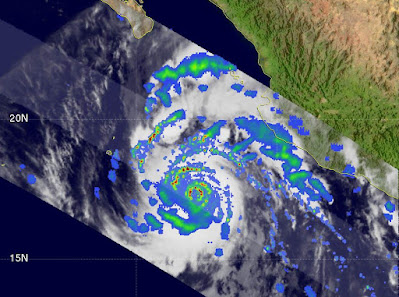Duration September 20 – October 2
Intensity 130 mph (215 km/h) (1-min), 945 mbar (hPa)
Part of the same tropical wave that formed Tropical Storm Danny in the Atlantic crossed over the Isthmus of Panama and became a disturbance in the Intertropical Convergence Zone during mid to late September. On September 20 the cloud pattern had increased in organization and the system was designated a tropical depression.
Continuing to strengthen, the depression became a tropical storm on September 21. The tropical storm then headed towards the northwest. Development was rapid, especially after September 22 as a banding type eye was forming. Further rapid development took place by the following day and the maximum sustained winds increased to near 130 mph (210 km/h) by the afternoon of September 23.
Later, on September 24, Hurricane Jimena reached its peak with maximum winds of 140 mph (230 km/h) and a minimum central pressure of 945 hectopascals (27.9 inHg). Jimena maintained itself as a powerful hurricane for three days, moving west until September 26, when it turned toward the west-northwest. Hurricane Jimena began to weaken on September 27. A northwestward movement commenced on September 29 in response to a large upper level trough which developed in its northwest. It continued to weaken and on September 30 it regained tropical storm intensity before becoming downgraded to a depression. On October 2, Jimena dissipated as a tropical cyclone. Hurricane Jimena caused no reported damage or casualties.
HURRICENA JIMENA 1991 VIDEO:




